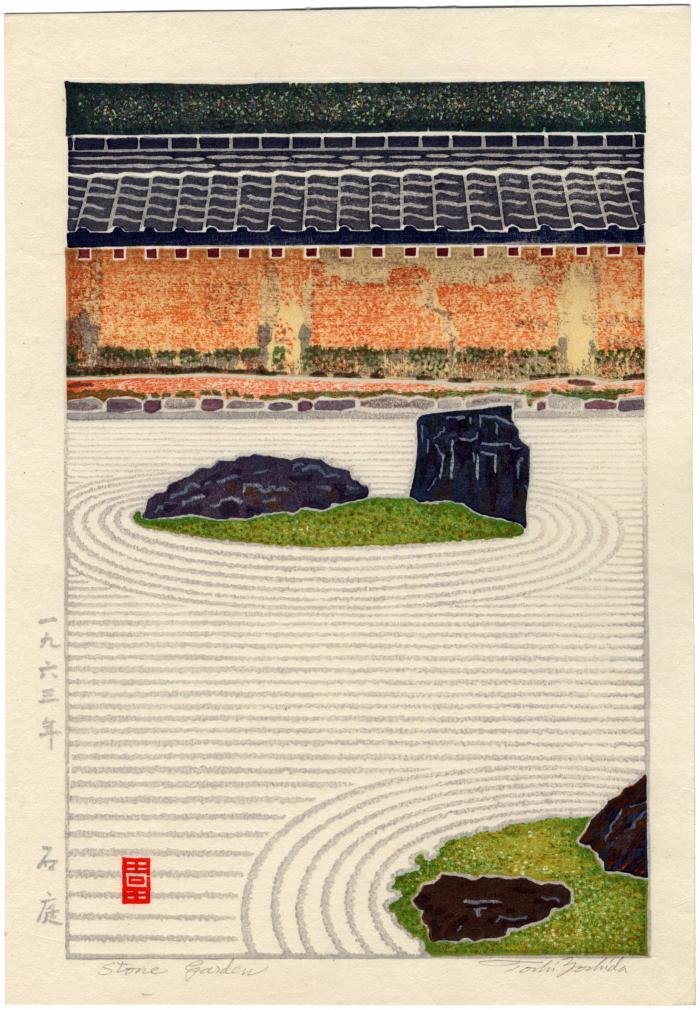Yoshida Tōshi (吉田遠志) (artist 1911 – 1995)
Stone Garden (Ishi Niwa - 石庭)
1963
9.75 in x 13.9375 in (Overall dimensions) Japanese woodblock print
Title: Stone Garden (石庭)
Printed signature in English: Toshi Yoshida
Artist's seal: Yoshida
Date: 1963 (一九六三年)
Asian Art Museum, San Francisco - a similar Sekino print from 1957 (possibly a model)
Los Angeles County Museum of Art Scholten Japanese Art noted: "In 1963-1964 Toshi Yoshida produced a group of landscape prints depicting both famous and unidentified gardens utilizing a 'white outline' format in a limited palette that made much use of the lightness and texture of the paper. Although not identified, this composition depicts the dry landscape garden at the late 15th century Zen Buddhist temple Ryoan-ji located in Kyoto."
****
In a description of the 1957 print of this same scene by Sekino in the Asian Art Museum in San Francisco it says:
"This print represents the famous stone garden of Ryoanji, a Zen temple in Kyoto. Several rocks are situated in a sea of white gravel; an adobe wall with a tiled roof isolates the garden from the outside world. By creating a strong simple composition, the artist got to the core of the scene.
This renowned garden was constructed in the early seventeenth century. Its beauty resides in the design of the landscape, which consists of stones set in a perfectly flat plot of ground. Its simplicity inspired many early-twentieth-century artists in the making of their "creative prints" (sosaku hanga).
Although his prints often seem abstract, Sekino stated that he did not aim to produce nonrepresentational art. Rather, he discovered his personal idiom in the use of sharp, clear forms and lines."

Ryoanji Zen Garden in Kyoto
****
There is another copy of this print in the Worcester Art Museum. Their curatorial files say of this print:
"This print depicts a section (on the far right) of the rectangular stone garden of Ryoan-ji (“Temple of the Dragon at Peace”; founded 1450) in Kyoto. Inspired by Chinese Zen paintings, this dry landscape garden ("kare-sansui") can be defined as an “artwork of the void” which is to be contemplated from a fixed vantage point. The garden is bordered by a long porch attached to the abbot’s quarters which can accommodate meditating monks seated in a row; it is also surrounded by low walls on three sides. As seen in this print, the wall behind the garden is stained by age with subtle brown and orange tones."
"The garden features five rock groupings: one group of five stones, two of three stones and two of two stones. The rock groupings (each surrounded by moss) are carefully distributed within the expanse of raked, white gravel that symbolizes water as well as the Buddhist concept of Emptiness. When looking at the garden from any angle (other than from above) only fourteen of the fifteen boulders are visible at one time. As consciousness turns inward and deepens into insight during meditation, the stones are experienced as part of a larger whole; it is said that when attaining enlightenment one is also able to view the fifteenth boulder."
landscape prints (fūkeiga 風景画) (genre)
modern prints (shin hanga - 新版画) (genre)
